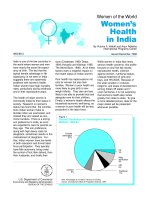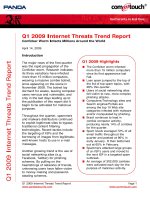LEADING WITH CARE how women around the world are inspiring businesses, empowering communities, and creating opportunity docx
Bạn đang xem bản rút gọn của tài liệu. Xem và tải ngay bản đầy đủ của tài liệu tại đây (1.63 MB, 227 trang )
Praise for Leading with Care
‘‘If you think your life is full of obstacles, read this book.
Mary Cantando delivers a no-holds-barred account of
women who have faced the toughest obstacles, yet
managed to come out on top. LEADING WITH CARE
captures the wisdom of women from the far corners of
the earth who went from surviving to thriving. The
Institute for Economic Empowerment of Women, a
partner with CARE, helps women business owners feed
their families and rebuild their countries. Together, we
provide Peace through Business
®
.’’
—Terry Neese, cofounder and president, Institute
for Economic Empowerment of Women
‘‘LEADING WITH CARE provides readers with seemingly
impossible accounts of women who glow by finding a way
to succeed in the harshest conditions. Brimming with
inspiration of extraordinary women, this book will
prompt you to give gratitude to the blessings you
currently have as well as motivate you to find ways to
apply their lessons to your own life.’’
—Sandra Yancey,founderandCEO,
eWomenNetwork Inc.
‘‘LEADING WITH CARE is no dry recitation of
management theories. Rather, it introduces the reader to
remarkable women, each eager to prove that anyone with
passion and commitment can achieve her goals. Even the
most successful women in business will be enlightened by
the lessons Mary Cantando brings to light in this book.’’
—Helen Han, interim executive director, National
Association of Women Business Owners
‘‘LEADING WITH CARE captures the essence of true
leadership. When a woman reaches deep inside to find
the courage and commitment to change the world
around her, she exhibits a powerful lesson that is relevant
from the board room to the village square. These stories
teach that lesson.’’
—Caroline Whitson, president of Columbia College
and founder of the SC Alliance for Women
‘‘LEADING WITH CARE recounts amazing stories of
women from the far corners of the earth who have
become successful beyond their wildest dreams. Mary
Cantando has captured the wisdom of women who went
from surviving to thriving in developing nations, and
then brings them to you as the most unlikely, but
powerful mentors.’’
—Marti Barletta,author,Prime Time Women and
Marketing to Women
‘‘LEADING WITH CARE brings together the struggles and
successes of some of the most amazing women in the
world. Imagine starting a business with a loan for $1.40 or
being responsible for providing water for your entire
community. These women are heroines in the truest
sense, and once you meet them your life will be forever
changed.’’
—Susan Solovic, CEO, SBTV.com
LEADING
WITH
CARE
how women around the world are
inspiring businesses,
empowering communities,
and creating opportunity
;
MARY CANTANDO
Foreword by Sheila C. Johnson
Founder and CEO, Salamander Hospitality
Global Ambassador, CARE
Afterword by Dr. Helene Gayle
President and CEO, CARE
Copyright © 2009 by Mary Cantando.
Published by Jossey-Bass
A Wiley Imprint
989 Market Street, San Francisco, CA 94103-1741—www.josseybass.com
No part of this publication may be reproduced, stored in a retrieval system, or transmitted in any
form or by any means, electronic, mechanical, photocopying, recording, scanning, or otherwise,
except as permitted under Section 107 or 108 of the 1976 United States Copyright Act, without
either the prior written permission of the publisher, or authorization through payment of the
appropriate per-copy fee to the Copyright Clearance Center, Inc., 222 Rosewood Drive, Danvers,
MA 01923, 978-750-8400, fax 978-646-8600, or on the Web at www.copyright.com. Requests to
the publisher for permission should be addressed to the Permissions Department, John Wiley &
Sons, Inc., 111 River Street, Hoboken, NJ 07030, 201-748-6011, fax 201-748-6008, or online at
www.wiley.com/go/
permissions.
Readers should be aware that Internet Web sites offered as citations and/or sources for further
information may have changed or disappeared between the time this was written and when it is
read.
Limit of Liability/Disclaimer of Warranty: While the publisher and author have used their best
efforts in preparing this book, they make no representations or warranties with respect to the
accuracy or completeness of the contents of this book and specifically disclaim any implied
warranties of merchantability or fitness for a particular purpose. No warranty may be created or
extended by sales representatives or written sales materials. The advice and strategies contained
herein may not be suitable for your situation. You should consult with a professional where
appropriate. Neither the publisher nor author shall be liable for any loss of profit or any other
commercial damages, including but not limited to special, incidental, consequential, or other
damages.
Jossey-Bass books and products are available through most bookstores. To contact Jossey-Bass
directly call our Customer Care Department within the U.S. at 800-956-7739, outside the U.S.
at 317-572-3986, or fax 317-572-4002.
Jossey-Bass also publishes its books in a variety of electronic formats. Some content that appears
in print may not be available in electronic books.
Library of Congress Cataloging-in-Publication Data
Cantando, Mary.
Leading with care : how women around the world are inspiring businesses,
empowering communities, and creating opportunity / Mary Cantando ;
foreword by Sheila C. Johnson.–1st ed.
p. cm.
Includes bibliographical references and index.
ISBN 978-0-470-49963-4 (cloth)
1. Women in development–Developing countries. 2. Poor women–Developing countries.
3. Entrepreneurship–Developing countries. 4. Leadership in women–Developing countries.
I. CARE/International. II. Title.
HQ1240.5.D44C36 2009
305.48
96942091724–dc22
2009019777
Printed in the United States of America
first edition
HB Printing 10987654321
For John.
On a scale of one to ten,
you’ve made my life an eleven.
And for the amazing young women in my life:
Suzanne, Heather,
Amy, and Megan.
Contents
;
Foreword ix
Sheila C. Johnson, Founder and CEO, Salamander
Hospitality; Global Ambassador, CARE
Introduction 1
Part One
developing self-sufficiency
7
1. Creating Self-Sufficiency Through Training 11
2. Blazing a Path Through Sports 20
3. Overcoming Challenges to Achieve
Self-Sufficiency 31
4. Gaining Self-Sufficiency While Helping Others 36
5. Implementing Self-Sufficiency in Your Own Life 41
Part Two
capitalizing on opportunity
45
1. Capitalizing on Opportunity in Niger 47
2. Seizing Good Fortune 57
3. Building a Different Kind of Business 66
4. Overcoming Naysayers 71
5. Capitalizing on Opportunity in Your Own Life 75
Part Three
building community
81
1. Building Community in India 87
2. Building Community Everywhere 94
vii
viii Contents
3. Joining Forces in the Business World 103
4. Creating an Advisory Board Community 109
5. Building Community in Your Own Life 112
Part Four
protecting the environment
through action and policy
117
1. Providing Clean Water in Mozambique 122
2. Protecting the Environment Through Corporate
Leadership 129
3. Saving the Environment One Plate at a Time 139
4. Building for the Future 145
5. Safeguarding the Environment in Your Own Life 149
Part Five
addressing discrimination
153
1. Overcoming Discrimination Through Literacy 156
2. Addressing Discrimination Through C orporate
Leadership 163
3. Learning to Capitalize on the Differences 175
4. Overcoming Bias in the Legal Profession 180
5. Addressing Discrimination in Your Own Life 185
A Final Note from the Author: Leaving a Legacy 189
Learning More About These Women
and Organizations 191
Afterword 195
Dr. Helene Gayle, President and CEO, CARE
Acknowledgments 203
About the Author 205
Index 206
Foreword
;
A
s a global ambassador for C ARE, I have witnessed firsthand
the remarkable ability of women to endure. In dirt-poor
towns and ramshackle villages, I’ve seen women, young and old,
maintain hope and optimism, even as the challenges of poverty,
disease, and cultural biases shadow their every move.
What these women have is strength. What they have is a
life force from which they draw a seemingly endless supply of
power. That’s why the humanitarian organization CARE puts
women at the heart of its efforts to eliminate root causes of
extreme poverty. CARE understands women’s power to spark
change—even in the poorest communities. Similarly, I am not
surprised to read the author’s conclusion that humanity’s best hope
to break the insidious cycle of poverty is to empower women.
Until women can vote and hold office; until they are allowed
to start businesses, to own homes, and to teach; until they are
afforded the rights, the privileges and, ultimately, the respect of
full citizenship, such poverty will never end.
Even in the United States, one has to look no further
than the poorest communities, especially in African-American
neighborhoods in many of our cities. Whatever sense of family and
community exists does so because of the enduring presence of a net-
work of incredibly strong women. Those women—we women—
are the linchpins of our families and our communities. And
because we serve as the delicate threads that hold together the
fabric of our societies, we have it in our power to effect meaningful
and lasting change.
I once co-chaired a dinner to fund AIDS research, and we
used the occasion to honor actress Ashley Judd and singer and
humanitarian Bono, of the rock group U2.
ix
x Foreword
I’ll never forget Bono’s comments. He bounded onstage,
thanked us for his award, and then—with his unparalleled
charm—compared women to lionesses.
Let me explain: An African friend had pointed out to Bono
that the success of a lion pride is due largely to the females’ ability
to hunt and to protect the young. The ‘‘King of the Beasts’’ would
be lost without the support of strong females.
Bono then started listing some of the powerful women who
were in attendance that evening.
‘‘Nancy Pelosi,’’ said Bono, adding with a smile the phrase
‘‘Madame Speaker.’’ He then took a beat and said in a half growl,
‘‘lioness.’’
‘‘Ashley Judd,’’ he added, ‘‘ lioness.’’
And he kept ticking off the names—one powerful woman after
another—and after each one he would take a good long beat and
say in that thick Irish brogue of his, ‘‘lioness.’’
Well, my friends, that’s what you’ll find in this book: stories by
and about lionesses. I hope you enjoy them and can learn from
them, just like those of us who work with CARE continue to learn
from the countless strong-willed women who are working hard to
create a better future for the whole world.
Middleburg, Virginia Sheila C. Johnson
July 2009 Founder and CEO, Salamander Hospitality
Global Ambassador, CARE
Introduction
;
W
hen we think of women in developing countries, our minds
immediately flash to what they need, what we can give to
them,howwe can help them . But what if we flipped this notion
upside down? What if those of us who are well educated and well
fed considered what we could learn from them—how they could
help us?
Those who find the greatest success in business and the most
satisfaction in life are often eternal students. This is especially true
of women. We’re always studying what others are doing and how
they’re doing it.
Of course, there are expected ways to learn these things: taking
courses and workshops, reading books by accomplished leaders,
watching how successful people get things done.
And there are unexpected ways.
Certainly, a successful, well-educated woman—a corporate
executive in New York City, an entrepreneur in Dallas, or a non-
profit leader in Seattle—would have little to learn from a woman
struggling to feed her family in Bosnia, or one building a microbusi-
ness in Zambia, or one teaching fellow villagers to read in Haiti.
Or so we think.
But the wisest among us know that life’s most valuable lessons
are often learned in unexpected places and from unexpected teach-
ers. This book will bring you into the lives of these unexpected
teachers—women whose minds and hearts have been ignited by
the global humanitarian organization CARE.
1
2 Leading with Care
An Organization Making a World of Difference
Consider these statistics:
• Women do about 66 percent of the world’s work but
earn only 10 percent of the world’s income.
• Women produce 50 percent of the world’s food but
own just 1 percent of its farmland.
• Of those living in extreme poverty, 60 percent are
women and girls.
• Nearly 66 percent of children who do not attend
school are girls.
Although these statistics demonstrate the unfair burden that
women carry, they are also an indication of the opportunity for
change that exists.
Each year CARE makes that opportunity real for fifty-five
million people in sixty-six developing countries. As one of the
leading humanitarian organizations in the world, CARE fights
global poverty by equipping poor women with the resources they
need to transform their lives. CARE supports women through
community-based initiatives that advance basic education,improve
health, i ncrease economic opportunity, and meet emergency needs
during and after disasters.
It is no accident that women and girls are at the heart of
CARE’s initiatives to end global poverty. Both domestically and
abroad, restoring a community starts first at home by valuing
education and health care. When poor women have access to
resources and information, they are able to help their families
escape poverty and strengthen their communities as well.
Formed in 1945 to support the rebuilding of Europe following
World War II, CARE was initially known for the ‘‘CARE Packages’’
that they distributed to refugees across the war-torn continent.
Introduction 3
From those parcels of food to programs that help people create
their own solutions to poverty, CARE h as touched countless
millions of lives around the globe.
Drawing strength from over sixty years of experience, CARE
approaches the needs of women and communities from five distinct
perspectives, each providing an opportunity for dramatic change:
• Strengthening capacity for self-help
• Providing economic opportunity
• Supporting and building communities
• Influencing policy related to the environment and
providing relief for emergencies and disasters
• Addressing discrimination
Following these guiding principles, CARE has proven time and
time again that their focus on women and girls as agents of change
creates exponential results. When CARE supports a girl’s educa-
tion, she passes her knowledge along to others in her family and her
community. When CARE offers a woman health services one day,
she r eturns the next day, bringing a neighbor who i s also in need.
When CARE provides a woman with a microloan and business
training, she not only creates a livelihood for herself and her family,
but she creates jobs for others in her village. With CARE, small
investments in women show huge returns, not only for the women
themselves but for their families and communities as well.
In today’s world of ever-shifting borders, ongoing wars, and
environmental uncertainty, CARE remains focused on rebuilding
lives. Regardless of America’s own economic situation, individual
women, as well as corporations and institutions, cannot ignore the
suffering in so many parts of the world. And as we look toward
the future, we must provide for t he education and health of the
world’s children—our children—who are our only hope.
4 Leading with Care
For that very reason, many of the world’s largest corpora-
tions support CARE. Having witnessed the lasting differences that
CARE brings to communities in need, these corporate supporters,
as well as individual CARE donors, have come to trust that CARE’s
enablement of community, opportunity, and education i s one of
our best hopes for righting some of the world’s wrongs and building
the future that our children need and deserve.
A Unique and Powerful Approach to Leadership
Having built my business on supporting women entrepreneurs, I
have long been intrigued by CARE’s focus on women. The more
I became involved with the organization and understood how
women and girls bear the brunt of poverty, the more determined
I was to do something about it. That is why I am so thrilled to
share this book with you. It is the culmination of my eighteen
months of research about amazing women who have struggled
through unimaginable circumstances to achieve self-sufficiency
and ultimate success.
Leading with Care is structured around CARE’s five perspectives,
listed earlier. Part One is ‘‘Developing Self-Sufficiency’’; Part Two
is ‘‘Capitalizing on Opportunity’’; Part Three is ‘‘Building Commu-
nity’’; Part Four is ‘‘Protecting the Environment Through Action
and Policy’’; and Part Five is ‘‘Addressing Discrimination.’’ As we
move through each of these topics, you will see how every one
of these principles can create a mind shift, both in developing
countries and in your own world.
In each part, we first meet a woman who has improved her
own life and the lives of those around her by taking advantage
of opportunities provided by CARE. We witness firsthand how
she is able to create a new business or lead a major shift in her
community, while providing for her family and building a better
future for the next generation. But these are not just stories; they
are examples of real lives being changed. You will see how each
Introduction 5
woman’s determination causes h er to do more, to be more for her
family and her community.
And as you read these seemingly impossible accounts of women
who have found a way to succeed in the harshest conditions, I chal-
lenge you to look for ways to apply their lessons to your own life. If a
woman in Niger can build a successful business starting with a loan
of $1.40, what can you do with your resources? If a twenty-year-old
in India can provide basic health care services for her village, what
can you do to help your neighbors? If a woman in Mozambique
can work seven days a week to bring water to her village, what can
you do to safeguard the environment in your corner of the world?
As you learn from t hese women and others like them, allow their
lessons to carry over to the day-to-day activities of your own life:
the way you save or spend your money, the way you support your
colleagues and neighbors, the way you affect the environment.
After learning from a woman who has turned her life around
with the help of a CARE program, we next explore the experiences
of successful women executives on the same topic. Here, we
discover what each of these executives has learned from CARE,
how CARE’s message resonates with her, and how she gives back.
In many instances, the women involved had already been longtime
supporters of CARE, but a few were introduced for the first time to
CARE through their participation in this book. They found their
own stories reflected in the accounts of the CARE women and are
now benefactors.
After l earning from these women, we wrap up each part by
discussing ways to integrate the concept in your own life, and we
offer specific questions to get you started.
At the end of the book, you will also find a resource section with
further information on all the women, organizations, and events
that you’ll read about.
In anever-shifting world, you will discover why CARE’smessage
is timeless. You’ll see h ow the women’s practical approach to
building businesses and self-sufficiency—in any economy, in any
6 Leading with Care
nation—gives us all hope for the future. And you’ll discover how
to implement what you learn in your own life.
Moving Toward a Better World for All Women
Leading with Care provides leadership concepts you could not
learn anywhere else, in a format you’ve never before experienced.
Through these pages, you’ll gain years of experience from women
who have earned the right to tell their stories.
No matter how successful you’ve been, traveling the path with
these women will bring you to greater success. That’s our goal: to
learn from each other to create a more perfect world for women
everywhere.
Part 1
;
developing
self-sufficiency
J
ust what makes a woman self-sufficient?
Is it money, education, a sense that she knows where she’s
going i n life? Is it her ability to stand on her own in any situation
and appear calm no matter what? Or is it her power to start with
absolutely nothing and build a magnificent life? Perhaps she makes
decisions based on what she believes is right rather than what is
popular. Or maybe she has the ability to bounce back from every
challenge that comes her way.
Regardless of your definition, I think you’ll agree that a
self-sufficient woman motivates others by the example she sets.
She projects strength and energy. She brings calm to chaos, per-
spective to problems, reassurance to crises—and when things are
going well, she really shines.
Those of us who live in relatively stable environments with
the basic necessities of life may take self-sufficiency for granted.
But what about women in developing nations who struggle to feed
their children, women who walk several hours every day just to
access water, women who cannot read or write because they never
had the opportunity to attend school? How do such women step
onto the path to self-sufficiency?
8 Leading with Care
Recognizing a Need
Global humanitarian organization CARE recognizes that women
around the world suffer disproportionately from poverty and lack of
opportunity. In economically depressed nations, women continue
to be held back, and only when they have the chance to reach
for independence are they able to live secure, thriving lives. For
more than sixty years, CARE has enabled women in developing
countries to improve their lives through programs that address the
particular needs of their own regions of the world.
Because gains for women result in gains for entire families,
CARE programs focus on at-risk women and girls. One program in
India, for example, teaches women the technical skills to become
leather artisans and the business skills to sell the items they produce.
In Bolivia, CARE facilitates alliances between produce growers and
international export companies to ensure that women are paid a fair
price for their products. In Kenya, CARE provides family planning
information and strengthens the local health system to improve
women’s health and quality of life.
As such programs (and hundreds of others) gain a foothold,
women have the opportunity to become self-sufficient by learning
about and then claiming their rights to education, income, and
health, often for the first time in their lives. This newfound
independence then leads women to seek greater participation and
voice in their communities, creating a ripple effect across society.
By helping women create new opportunities, CARE challenges
generations of negative beliefs that have limited not only individual
women but their families and communities as well.
To be clear, however, CARE cannot make a woman self-reliant.
She mustdo that for herself. CARE’s role is to provide the education
and tools that women need, help change the social structures that
limit their choices, and encourage women to unite to claim their
rights. By deciding to capitalize on these opportunities, women
take the first step toward gaining the personal i ndependence that
they will carry with them for the rest of their lives.
Developing Self-Sufficiency 9
Creating Opportunities for Self-Reliance
From one continent to the next, one economy to the next, one
community to the next, CARE responds appropriately to women’s
needs and traditions. From Afghanistan to Guatemala to Zim-
babwe, by providing the basic components for self-sufficiency,
CARE helps women transform their lives. And often in the pro-
cess, these very w omen become leaders in their communities and
go on to transform the lives of others.
In Afghanistan, for example, after generations of conflict, girls
are finally gaining the opportunity for basic education through sixth
grade, but anything beyond that is still largely out of reach. This
is particularly true in rural areas where fewer schools and teachers,
combined with more conservative attitudes, tend to keep girls
at home. To bridge this gap, CARE created fourteen specialized
schools for girls in the seventh, eighth, and ninth grades. Besides
educating the hundreds of girls enrolled in this program, CARE has
trained forty-two new teachers. The beauty of this program is that
it moves multiple generations of women toward self-sufficiency by
ensuring that the students of today have an opportunity to learn,
while women are trained to teach the students of tomorrow.
Thousands of miles away, in Madagascar, CARE’s food-for-work
programs provide both short-term hunger relief and long-term
infrastructure enhancement, while helping women learn skills
to increase their independence. Through the program, women
are paid in food wages for both training and for w orking on
community projects such as water and sanitation systems. These
projects provide income and food for about 10,000 households, as
well as improvements to environmental and health infrastructure,
ultimately benefiting not only those directly involved but about
200,000 others in the region. By providing training and jobs
through this effort, CARE enables women to feed their children
today and learn skills that they can take into tomorrow—all
while making a long-lasting impact on the infrastructure of their
country.
10 Leading with Care
The women of Nepal have long lived on the fringes of society. In
response to the generations-old pattern of discrimination, CARE
initiated a five-year project in 2007 called Women and Youth
as Pillars of Sustainable Peace. This forward-thinking program
engages poor, socially excluded women and youth to work toward
a democratic constitution and eventual peace in the region. One
of the ultimate goals of this project is to influence government
policy so that women’s rights are protected. By involving the very
women who will benefit from the program, CARE is helping them
become self-sufficient while making a difference in the future of
their country.
In rural Egypt, where only 2 percent of girls complete secondary
school, the lack of classrooms and teachers prevents girls from
getting an education. Gender bias creates even further problems,
as the language and behavior of t eachers send the message that
boys are more intelligent and capable than girls. In response to
this multifaceted challenge, CARE has partnered with other orga-
nizations to launch an initiative called the New School Program.
As more and more girls become a part of this program and obtain
an education, they are able to pass along their knowledge and
serve as role models for the next generation of rural Egyptian
girls.
In Uganda, women and girls have long been the targets
of abduction, maiming, rape, physical assault, and forced early
marriages. CARE’s Women’s Empowerment for Peace program
supports those who have survived such violence and helps them
develop the skills and ability to stand up for their rights. Among
other goals, the program is helping twelve thousand women and
girls seek redress for atrocities they have suffered. By enabling
these women to acquire what is rightfully theirs, CARE is helping
them increase their incomes and participate more fully in local
decision-making policies.
In a rural area of Guatemala, where two-thirds of the population
is illiterate, a unique CARE program combines microloans for
Developing Self-Sufficiency 11
indigenous women with a three-year education program for their
daughters. Working through a distance education program, these
girls access educational videocassettes and watch televised classes
to complete school and earn their diplomas. By helping mothers
build small businesses through microloans, while educating their
daughters—perhaps to own their own businesses someday—CARE
is helping back-to-back generations of indigenous Guatemalan
women find new strength and opportunity.
By looking at these examples, which represent just a hand-
ful of CARE’s ongoing initiatives, you can begin to see some
of the ways that CARE helps women move toward the future
by customizing solutions t o meet the particular needs of each
region. By analyzing each situation and then providing an appro-
priate response, CARE is able to make the greatest impact on
the greatest number of women—helping millions move toward
self-sufficiency.
;
CREATING SELF-SUFFICIENCY
THROUGH TRAINING
As a teenager, Maria Landa gained her training and confidence in
a CARE-sponsored welding program; she then used a loan from
CARE to expand her small metal-fabrication business to provide
jobs to fellow townspeople. From a business perspective, Maria’s
story would be f ascinating enough: she created a new business
model, identified a new market for metal construction and scaf-
folding, and, ultimately, created an entire new industry. But her
story goes far beyond developing a financially stable business, as
she used the skills and resources she originally obtained from
CARE to later support the organization’s relief efforts by building
shelters for thousands of fellow Peruvians following a disastrous
earthquake.
12 Leading with Care
Living an Unlikely Life
If you want to visit Maria, you must travel to Villa El Salvador,
where the dusty, pot-holed roads all look the same, and the lines
of low-lying roofs crowd the view in every direction. There on one
particular block you’d notice a freshly painted, two-story building.
Although a seemingly ordinary sign, ‘‘Santa Maria Enterprises,’’
hangs above the storefront, this business is anything but ordinary.
In fact, its very existence is an unlikely story.
Forty years ago, this entire area of Peru was a barren spot in the
desert. Built from scratch on the outskirts of Lima, the settlement
of Villa El Salvador was established as a refuge for poor migrants
in 1971. Now this urban area is bursting at the seams, with a
population that has swelled to over 400,000. Andits inhabitants toil
day after day in harsh poverty. Yet in spite of a tarnished landscape
and rampant crime, this self-governed community is the envy
of Peruvians struggling to better their lives. That’s because Villa
El Salvador provides the education, health care, and municipal
services that most communities of the region do not.
It is here that Maria Landa has created a quality of life that many
Peruvian women cannot even dream of. At age thirty-one, Maria
defies the status quo, as she is an unmarried business owner andprop-
erty owner. Like her hometown, Maria has become self-sufficient.
As the head of Santa Maria Enterprises, she has come to represent
just what is possible for working women across Peru.
With her entrepreneurial success and stellar reputation as one
of the country’s best welders, Maria makes it look easy, as if
everything just fell into place. Not so. Her journey to being named
Miss Micro-Entrepreneur of Lima defies the odds.
Following the Dreams of Her Childhood
Unlike most girls growing up in her region, Maria was never
limited by gender expectations. Her parents, entrepreneurs them-
selves, never steered her toward the traditional domestic role of
Developing Self-Sufficiency 13
most Peruvian women. And during her days at an all-girl Catholic
primary school, the nuns demonstrated to Maria and her school-
mates that there was no limit to what girls could learn and achieve
by teaching them skills that were usually reserved for boys, such as
car repair. Instead of being influenced to follow a restrictive female
path, Maria was empowered to do anything and be anything. She
was groomed to follow her dreams.
But following dreams was easier said than done, when living in a
shantytown for the working poor. If it had not been for her parents,
who prioritized schooling at all costs, Maria would have been just
another struggling girl with limited opportunity and means. But
within their modest home, Maria, her sisters, and her brother were
encouraged to reach for something more.
In 1994, when Maria was just seventeen and a recent high
school graduate, her father came home with a flyer that would
change her life. CARE was offering a technical training program
for teens in the area. He discussed the idea with Maria and her
nineteen-year-old sister Elvira, and they both decided to give it a
shot. But when they arrived to register for the metal carpentry class,
it became clear that none of the male students expected women to
be a part of that class. In fact, the idea of women taking up any
trade, much less a dangerous one such as welding, w as unheard of
in their country. But having been raised by parents who believed
that their girls could do anything, the sisters weren’t discouraged
and continued to attend class. It took only a few days for them to
prove that they had a real feel for the work, and although the rest
of the class still regarded them s keptically, the commotion about
their presence began to subside. Six months later, they became the
first female graduates ever, and each landed apprentice work with
a local welding business.
The pair spent a lot of time practicing their new trade by
day—making doors, chairs, window frames, model airplanes, and
toy cars—while continuing their studies by night. After completing
her studies and apprenticeship, Maria became a contractor for the









